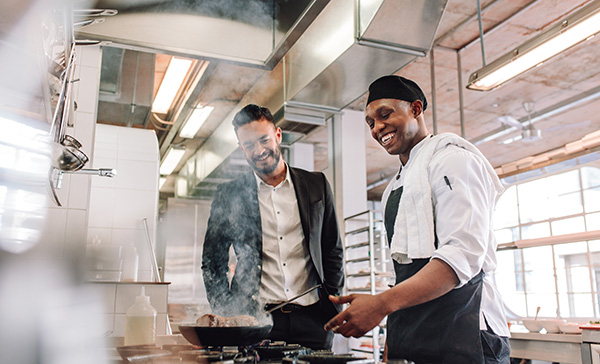Who Taught You to Change a Menu?

I've lost count of how many times I've sat in a meeting where someone said, with authority, “You should change your menu twice a year. Seasonal is key.” Heads nod around the table. It sounds smart, responsible, even exciting. But I always want to stop the conversation right there and ask: Who taught us that? And more importantly, who actually taught us how?
It's one of those rules that drifts through the industry like background music. Consultants repeat it on podcasts, in workshops, in glossy articles: change your menu with the seasons. Keep things fresh. Show your creativity. And yet, when you ask most chefs and owners how they actually learned to do it, there's a long pause. Because behind that neat bit of advice is a messy, human process that few of us were ever shown.
When I was young in this business, my first chef didn't talk about “menu change cycles.” He talked about ingredients. We would stand at the back door together when deliveries came in, and he would hold up a bunch of herbs or a box of peaches and say, “Feel this. Smell this. This is what's good right now.” Our menu changed because he was awake to the seasons, not because of a date on the calendar. That was my first lesson, though I didn't know it then: a menu isn't something you change because you're told to. You change it because what you're serving no longer tells the truth about what's available, what's delicious, or who you are.
But the industry grew up around us. Chains and franchises needed systems. Consultants carved rules into stone: two menu changes a year. Maybe four. Build R&D into your budget. Announce it with a press release. All fine ideas — on paper. In reality, I walk into restaurants every week as a hospitality coach and see something different. A laminated menu that hasn't changed in years because everyone's afraid to mess with what's selling. Or the opposite: a menu rewritten overnight, full of untested dishes, because someone decided they needed to look innovative. Both extremes cost money. Both ignore the deeper question: Do you know why you're changing this menu? And has anyone actually taught you how to do it well?
I've seen teams where “menu development” means a frantic Thursday meeting. Someone says, “Let's add a pasta. Let's try a new steak.” They scribble down ideas, cost them in their head, and pray the line can handle it on Friday night. No testing. No R&D day. No tasting panel with servers who need to describe these dishes to guests. No marketing plan to tell your regulars why you're excited. And then they wonder why the new dishes die quietly in the corner of the menu.
On the other hand, I've seen chefs who treat menu change like art and science combined. They take their team to the farmers' market in early spring and ask, “What's inspiring you?” They run three or four potential dishes as quiet specials, watch sales, gather feedback, adjust. They work with their accountant or manager to cost out every ounce and minute of labor. When the new menu launches, they tell the story on the menu itself, on social media, in conversations at the table. And you feel it as a guest: this isn't just a menu change. It's an evolution. It's care made visible.
Nobody taught most of us to do that. We cobbled it together from mentors, mistakes, and late-night conversations. I remember a particular fall, years ago, when we decided to revamp an entire section of our menu. We didn't sleep much. We tested dishes until three in the morning, then served breakfast at seven. Some ideas bombed. A few became signatures. That season taught me something no consultant ever mentioned: changing a menu isn't just logistics, it's culture. It's how you bring your team into the creative process, how you make them feel proud of what they're serving. If they don't believe in the new menu, your guests never will.
Consultants aren't wrong when they say, “Change your menu seasonally.” But advice without context is like a recipe without method. The real teaching happens in the kitchen, over cutting boards and late-night coffee, when someone older says, “Here's why we're changing this dish. Here's how we test it. Here's how we know if it belongs.” That's a different kind of lesson, one you can't get from a slide deck.
So, who taught you to change a menu? Was it a chef who believed in tasting everything ten times before it saw the light of day? Was it a consultant who handed you a strategy that didn't fit your operation? Was it no one at all, and you learned by making painful, expensive mistakes?
If no one taught you, that's okay. You can start teaching yourself and your team right now. Set aside a day every season for R&D not just cooking, but talking, dreaming, costing, testing. Run dishes as specials first. Collect feedback like treasure. Adjust. When you're ready, market the change proudly. Tell your guests why you're excited. Show them that your menu is alive, not just printed.
Changing a menu is more than a task on a to-do list. It's a statement: This is who we are today. Don't let it be something you do because someone told you to. Let it be something you do because you've learned, through experience and intention, that your food deserves to reflect the best of what you can offer right now.
And maybe, just maybe, the next time someone tells you, “Change your menu twice a year,” you'll smile and say, “Sure but let me tell you how we really do it.”
 Jay Ashton, Canada's Restaurant Guy, is the CEO of Ashton Media & Co-Host The Late Night Restaurant Podcast.
Jay Ashton, Canada's Restaurant Guy, is the CEO of Ashton Media & Co-Host The Late Night Restaurant Podcast.


